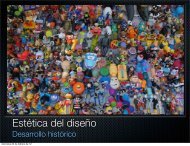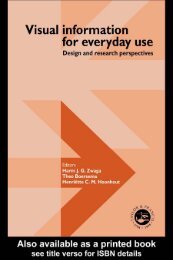- Page 2: VISUAL CULTURE Visual Culture is a
- Page 5 and 6: First published 1995 by Routledge 1
- Page 7 and 8: CONTENTS 10 TELEVISION: NOT SO MUCH
- Page 9 and 10: CONTRIBUTORS Malcolm Barnard is Sen
- Page 11 and 12: CONTRIBUTORS John A.Smith is Lectur
- Page 14 and 15: 1 THE CENTRALITY OF THE EYE IN WEST
- Page 16 and 17: AN INTRODUCTION Our contemporary vi
- Page 18 and 19: AN INTRODUCTION thesocial sciences
- Page 22 and 23: AN INTRODUCTION To abstract implies
- Page 24 and 25: AN INTRODUCTION Baudrillard it mere
- Page 26 and 27: AN INTRODUCTION Ironically it is as
- Page 28 and 29: AN INTRODUCTION empiricist tactics
- Page 30 and 31: AN INTRODUCTION etymology of the wo
- Page 32 and 33: AN INTRODUCTION The city, though tr
- Page 34 and 35: AN INTRODUCTION Jenks begins with B
- Page 36 and 37: AN INTRODUCTION orders of experienc
- Page 38 and 39: AN INTRODUCTION Relations. London:
- Page 40 and 41: ADVERTISING: THE RHETORICAL IMPERAT
- Page 42 and 43: ADVERTISING: THE RHETORICAL IMPERAT
- Page 44 and 45: Figure 2.1 Advertisement for Death
- Page 46 and 47: ADVERTISING: THE RHETORICAL IMPERAT
- Page 48 and 49: ADVERTISING: THE RHETORICAL IMPERAT
- Page 50 and 51: ADVERTISING: THE RHETORICAL IMPERAT
- Page 52 and 53: ADVERTISING: THE RHETORICAL IMPERAT
- Page 54 and 55: ADVERTISING: THE RHETORICAL IMPERAT
- Page 56 and 57: REPORTING AND VISUALISING and visua
- Page 58 and 59: REPORTING AND VISUALISING equipment
- Page 60 and 61: REPORTING AND VISUALISING If you wi
- Page 62 and 63: REPORTING AND VISUALISING a ‘real
- Page 64 and 65: REPORTING AND VISUALISING cover oth
- Page 66 and 67: REPORTING AND VISUALISING clear’,
- Page 68 and 69: REPORTING AND VISUALISING events ma
- Page 70 and 71:
REPORTING AND VISUALISING Poster, M
- Page 72 and 73:
FRACTURED SUBJECTIVITY with regard
- Page 74 and 75:
FRACTURED SUBJECTIVITY And there we
- Page 76 and 77:
FRACTURED SUBJECTIVITY from the ver
- Page 78 and 79:
FRACTURED SUBJECTIVITY complicated
- Page 80 and 81:
FRACTURED SUBJECTIVITY into existen
- Page 82 and 83:
FRACTURED SUBJECTIVITY Figure 4.4 G
- Page 84 and 85:
FRACTURED SUBJECTIVITY its continge
- Page 86 and 87:
FRACTURED SUBJECTIVITY appears to s
- Page 88 and 89:
FRACTURED SUBJECTIVITY not the cont
- Page 90 and 91:
5 THE CITY, THE CINEMA: MODERN SPAC
- Page 92 and 93:
THE CITY, THE CINEMA: MODERN SPACES
- Page 94 and 95:
THE CITY, THE CINEMA: MODERN SPACES
- Page 96 and 97:
THE CITY, THE CINEMA: MODERN SPACES
- Page 98 and 99:
THE CITY, THE CINEMA: MODERN SPACES
- Page 100 and 101:
THE CITY, THE CINEMA: MODERN SPACES
- Page 102 and 103:
THE CITY, THE CINEMA: MODERN SPACES
- Page 104 and 105:
THE CITY, THE CINEMA: MODERN SPACES
- Page 106 and 107:
THE CITY, THE CINEMA: MODERN SPACES
- Page 108 and 109:
THE CITY, THE CINEMA: MODERN SPACES
- Page 110 and 111:
FABULOUS CONFUSION! POP BEFORE POP?
- Page 112 and 113:
FABULOUS CONFUSION! POP BEFORE POP?
- Page 114 and 115:
FABULOUS CONFUSION! POP BEFORE POP?
- Page 116 and 117:
FABULOUS CONFUSION! POP BEFORE POP?
- Page 118 and 119:
FABULOUS CONFUSION! POP BEFORE POP?
- Page 120 and 121:
FABULOUS CONFUSION! POP BEFORE POP?
- Page 122 and 123:
FABULOUS CONFUSION! POP BEFORE POP?
- Page 124 and 125:
FABULOUS CONFUSION! POP BEFORE POP?
- Page 126 and 127:
FABULOUS CONFUSION! POP BEFORE POP?
- Page 128 and 129:
FABULOUS CONFUSION! POP BEFORE POP?
- Page 130 and 131:
FABULOUS CONFUSION! POP BEFORE POP?
- Page 132 and 133:
FABULOUS CONFUSION! POP BEFORE POP?
- Page 134 and 135:
FABULOUS CONFUSION! POP BEFORE POP?
- Page 136 and 137:
7 AN ART OF SCHOLARS Corruption, ne
- Page 138 and 139:
AN ART OF SCHOLARS The details are
- Page 140 and 141:
AN ART OF SCHOLARS The other world
- Page 142 and 143:
AN ART OF SCHOLARS The defeat of na
- Page 144 and 145:
AN ART OF SCHOLARS Determining the
- Page 146 and 147:
AN ART OF SCHOLARS because of, or b
- Page 148 and 149:
AN ART OF SCHOLARS an experience’
- Page 150 and 151:
AN ART OF SCHOLARS the fulfilment o
- Page 152 and 153:
AN ART OF SCHOLARS NOTES 1 It would
- Page 154 and 155:
AN ART OF SCHOLARS Rosen, Stanley (
- Page 156 and 157:
WATCHING YOUR STEP This phone call
- Page 158 and 159:
WATCHING YOUR STEP realisation of t
- Page 160 and 161:
WATCHING YOUR STEP It is not an ori
- Page 162 and 163:
WATCHING YOUR STEP understanding of
- Page 164 and 165:
WATCHING YOUR STEP ‘at home in th
- Page 166 and 167:
WATCHING YOUR STEP is to commend th
- Page 168 and 169:
WATCHING YOUR STEP an original imag
- Page 170 and 171:
WATCHING YOUR STEP The Victorian
- Page 172 and 173:
WATCHING YOUR STEP The Nichol was s
- Page 174 and 175:
9 REICH DREAMS Ritual horror and ar
- Page 176 and 177:
REICH DREAMS Secondly, and Steiner
- Page 178 and 179:
REICH DREAMS power took control of
- Page 180 and 181:
REICH DREAMS and technology, as in
- Page 182 and 183:
REICH DREAMS reaffirming the gratui
- Page 184 and 185:
TELEVISION: MORE A VISIBLE OBJECT w
- Page 186 and 187:
TELEVISION: MORE A VISIBLE OBJECT (
- Page 188 and 189:
TELEVISION: MORE A VISIBLE OBJECT (
- Page 190 and 191:
TELEVISION: MORE A VISIBLE OBJECT t
- Page 192 and 193:
TELEVISION: MORE A VISIBLE OBJECT t
- Page 194 and 195:
TELEVISION: MORE A VISIBLE OBJECT l
- Page 196 and 197:
TELEVISION: MORE A VISIBLE OBJECT I
- Page 198 and 199:
TELEVISION: MORE A VISIBLE OBJECT O
- Page 200 and 201:
TELEVISION: MORE A VISIBLE OBJECT D
- Page 202 and 203:
TELEVISION: MORE A VISIBLE OBJECT M
- Page 204 and 205:
FOUCAULT’S OPTICS death and not b
- Page 206 and 207:
FOUCAULT’S OPTICS flesh and tissu
- Page 208 and 209:
FOUCAULT’S OPTICS the region that
- Page 210 and 211:
FOUCAULT’S OPTICS Thus armed, the
- Page 212 and 213:
FOUCAULT’S OPTICS its significati
- Page 214 and 215:
FOUCAULT’S OPTICS 15 Foucault, Th
- Page 216 and 217:
MANAGING ‘TRADITION’ whether th
- Page 218 and 219:
MANAGING ‘TRADITION’ double (at
- Page 220 and 221:
MANAGING ‘TRADITION’ technoscie
- Page 222 and 223:
MANAGING ‘TRADITION’ might stil
- Page 224 and 225:
MANAGING ‘TRADITION’ already th
- Page 226 and 227:
MANAGING ‘TRADITION’ subject to
- Page 228 and 229:
MANAGING ‘TRADITION’ Knowledge-
- Page 230 and 231:
MANAGING ‘TRADITION’ calculativ
- Page 232 and 233:
PHOTOGRAPHY AND MODERN VISION cinem
- Page 234 and 235:
PHOTOGRAPHY AND MODERN VISION class
- Page 236 and 237:
PHOTOGRAPHY AND MODERN VISION visio
- Page 238 and 239:
PHOTOGRAPHY AND MODERN VISION —th
- Page 240 and 241:
PHOTOGRAPHY AND MODERN VISION demon
- Page 242 and 243:
PHOTOGRAPHY AND MODERN VISION Poton
- Page 244 and 245:
PHOTOGRAPHY AND MODERN VISION the u
- Page 246 and 247:
PHOTOGRAPHY AND MODERN VISION to kn
- Page 248 and 249:
PHOTOGRAPHY AND MODERN VISION The w
- Page 250 and 251:
PHOTOGRAPHY AND MODERN VISION Schaf
- Page 252 and 253:
THREE IMAGES OF THE VISUAL empirici
- Page 254 and 255:
THREE IMAGES OF THE VISUAL of time.
- Page 256 and 257:
THREE IMAGES OF THE VISUAL we must
- Page 258 and 259:
THREE IMAGES OF THE VISUAL to the f
- Page 260 and 261:
THREE IMAGES OF THE VISUAL attitude
- Page 262 and 263:
THREE IMAGES OF THE VISUAL (inadver
- Page 264 and 265:
THREE IMAGES OF THE VISUAL what pai
- Page 266 and 267:
THREE IMAGES OF THE VISUAL rather i
- Page 268 and 269:
THREE IMAGES OF THE VISUAL If I ins
- Page 270 and 271:
THREE IMAGES OF THE VISUAL mechanic
- Page 272 and 273:
THREE IMAGES OF THE VISUAL When art
- Page 274 and 275:
Bauhaus 19 Bauman, Z. 148 Bausinger
- Page 276 and 277:
formalism 6-7, 24, 89, 124, 239, 24
- Page 278 and 279:
Mayhew, H. 158 Meckel, Johann Fried
- Page 280 and 281:
Ruscha, Edward 100, 101-2, 111 Rutt
- Page 282:
witchcraft, anthropology of 79 Witt






